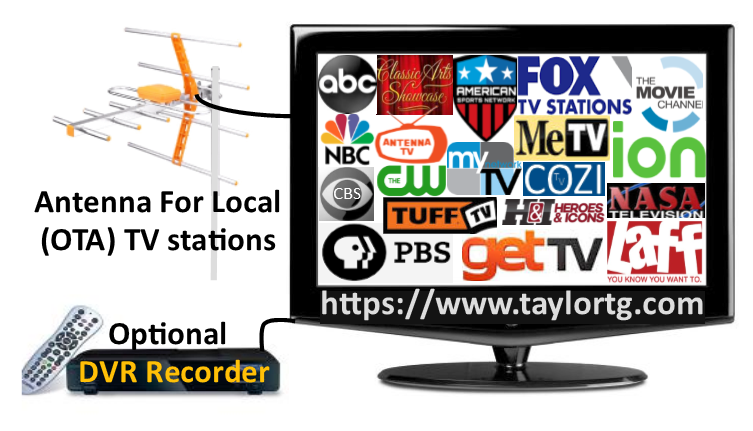
|
TV Overview - Basic Channel and Tower information |
|---|
|
You are viewing the TV Overview page: \/
Do not purchase any equipment before locating the TV transmitter towers in your city and what channels you may receive. TV Towers are seldom near their TV studios. Below on this page I list several sites that will show you where TV towers are in your neighborhood. Unless your TV is located within fifteen miles from the TV towers you will get many more stations and a more stable signal if you can place the antenna on the roof, or in the attic. Third floor or higher apartments and condos may receive decent signals with an indoor antenna if the antenna is near a window on the side of the apartment closest to the TV broadcast towers. Consider how the coax cable will get from your antenna to the TV set. All coax cables produce some signal loss. The longer the cable run, the larger the TV signal loss. I suggest you keep the coax cable length one hundred feet or shorter. Information about channel numbers
When TV
broadcast specifications changed from analog to digital so did the
frequencies most stations broadcast on. Stations now seldom
transmit on the actual channel they display on your TV. Digital TV
broadcast specifications have code that tells the TV set to display the
original old analog channel number of, say, channel 9 on the TV set, as
this was the stations original channel number, even though the TV
station may now be broadcasting on channel 26.1. Digital specifications allow for each channel to air multiple TV programs at the same time, on "sub-channels". Usually the first channel is their main network affiliation channel, such as ABC, CBS, or NBC. Their other channels would be independent networks, like Grit, METV, Decades, Laff, Escape, etc. A station might have twelve different channels, listed as 26.1; 26.2; 26.3; 26.4, and more.
While using the below web links for TV tower locations, review the TV channel list to see if any stations in your area broadcast on a channel below 14. Any channel below 14 is considered VHF (Very High Frequency). VHF signals require an antenna designed to capture VHF TV signals.
If you have a VHF channel in your area, do not purchase an antenna
unless the box specifies that it is designed to capture both VHF and UHF
bands. The old triangle shaped TV antenna on your grandparent's home still works for
digital TV today.
VHF High channels 8 - 13 UHF channels 14 - 51 Depending upon the distance from your home and the antenna you purchase, if the TV towers for stations you are likely to watch are over one hundred-degrees apart on the compass you may need a second antenna. I believe it better to combine two antennas than use a rotator, especially if you are going to use a DVR to record shows. You might accidently leave the rotator antenna pointed in the wrong direction when the DVR starts recording. Or you wish to watch a station south of your homestead while recording a program on a station located north of your home.
LINKS TO SEE YOUR AVAILABLE TV STATIONS.
An easy
site is the Antennas Direct site. This site has a simple design with the station name, channel,
and distance between the address you entered and each TV tower. This
site is a retail company that sells antennas. You do not have to
purchase anything on this site to use the tower locater function. Cancel
out any pop-up advertisements. ( I have bought antennas from this
company and I do like their products, but they are on the middle to
higher end of antenna prices).
Instead of inserting just your zip code, enter your entire
street address along with the zip on their zip code line for a
more accurate reading. No apartment number needed. Place a comma between
each data item. |
|
https://www.antennasdirect.com/transmitter-locator.html
Rabbit Ears ( www.rabbitears.info )
is a free site where a group of engineers provide technical
information on various topics including digital television
broadcasting. The information on this site is excellent
but a little technical for some and divided up on various pages.
DIRECTIONS:
1. In the bottom left of map enter your
information.
2.
Location: your street, your town, your state, your zip code
3.
Then click Search next to entry
4.
Map will change to highlight your location
5.
Now click on "Move Pushpin to center map view
6.
The latitude and longitude boxes will auto fill.
7.
Now click the GO button
This list will show you how far the tower is from your address,
in which direction and the signal strength. Some towers that are
closer to you might have a weaker signal than other towers
further away, because the nearby tower may use a low-power
transmitter.
Looking at the Signal Strength column: Once the signal strength
falls into and below 35, your TV reception could waver,
depending upon TV antenna strength, location, weather, along with
the quality of the television tuner. Better TV sets often have
better tuners. Tuners are not important when connected to cable
and satellite systems, but you do want a good tuner in your TV
(or DVR) if you are watching and recording Over-The-Air
television.
For those that do not trust retail sites because of security
reasons and cookie tracking advertisements, here is the USA
government site.
https://www.fcc.gov/media/engineering/dtvmaps
There are many other sites on the internet that offer various
degrees of broadcast station information.
|